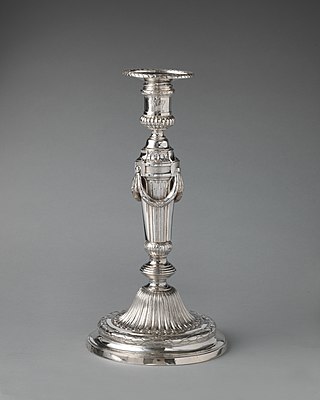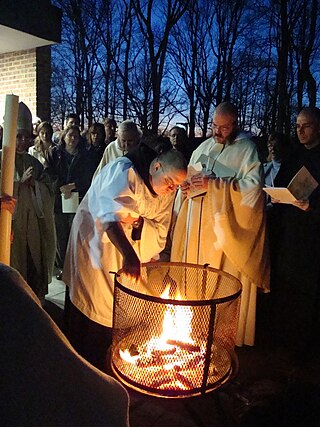Triple candlestick may refer to:

A Paschal candle is a large, white candle used in liturgies in Western Christianity. A new Paschal candle is blessed and lit every year at Easter, and is used throughout the Paschal season which is during Easter and then throughout the year on special occasions, such as baptisms and funerals.

In religion, a blessing is the impartation of something with grace, holiness, spiritual redemption, or divine will.
Wick most often refers to:

The Paschal Triduum or Easter Triduum, Holy Triduum, or the Three Days, is the period of three days that begins with the liturgy on the evening of Maundy Thursday, reaches its high point in the Easter Vigil, and closes with evening prayer on Easter Sunday. It is a moveable observance recalling the Passion, Crucifixion, Death, burial, and Resurrection of Jesus, as portrayed in the canonical Gospels.

A candlestick is a device used to hold a candle in place. Candlesticks have a cup or a spike ("pricket") or both to keep the candle in place. Candlesticks are less frequently called "candleholders".

Dikirion and trikirion are liturgical candlesticks, used by a bishop of the Eastern Orthodox and the Eastern Catholic Churches to bless the clergy and faithful. The words mean "dual candle" and "triple candle", respectively, and may collectively be called by the Greek plural form, "δικηροτρίκηρα", dikērotríkēra.

Tenebrae is a religious service of Western Christianity held during the three days preceding Easter Day, and characterized by gradual extinguishing of candles, and by a "strepitus" or "loud noise" taking place in total darkness near the end of the service.
Easter Vigil, also called the Paschal Vigil or the Great Vigil of Easter, is a liturgy held in traditional Christian churches as the first official celebration of the Resurrection of Jesus. Historically, it is during this liturgy that people are baptized and that adult catechumens are received into full communion with the Church. It is held in the hours of darkness between sunset on Holy Saturday and sunrise on Easter Day – most commonly in the evening of Holy Saturday or midnight – and is the first celebration of Easter, days traditionally being considered to begin at sunset.
A candlestick is a decorative holder for one or more candles.

A candelabra or candelabrum is a candle holder with multiple arms.

The ceremonial use of lights occurs in liturgies of various Christian Churches, as well as in Jewish, Zoroastrian and Hindu rites and customs.

Altar candles are candles set on or near altars for religious ceremonies. Various religions have regulations or traditions regarding the number and type of candles used, and when they are lit or extinguished, for example during the liturgies.
Candle holder or candleholder may refer to:

A triple candlestick was prescribed until 1955 in the Roman Rite Easter Vigil service, held on Holy Saturday morning.

The Paschal trikirion is a liturgical triple-candlestick used at Easter time in the Eastern Orthodox and Byzantine Catholic traditions.
Pontifical vestments, also referred to as episcopal vestments or pontificals, are the liturgical vestments worn by bishops in the Catholic, Eastern Orthodox, Oriental Orthodox, Anglican, and some Lutheran churches, in addition to the usual priestly vestments for the celebration of the mass, other sacraments, sacramentals, and canonical hours. The pontifical vestments are only worn when celebrating or presiding over liturgical functions. As such, the garments should not be confused with choir dress, which are worn when attending liturgical functions but not celebrating or presiding.

Easter fires, also called Paschal fires, are typically bonfires lit at Easter as part of liturgical and secular celebrations.

An altar crucifix or altar cross is a cross placed upon an altar, and is often the principal ornament of the altar.

The altar in the Catholic Church is used for the celebration of the Sacrifice of the Mass.
Paschal is a surname and given name.